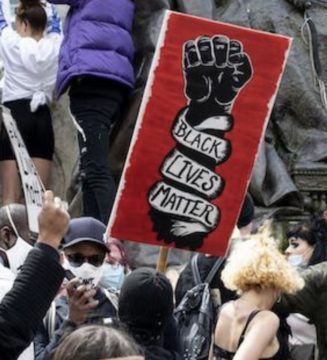Benjamin Wallace-Wells in The New Yorker:
 Television suits Peter Buttigieg. He is a dispassionate figure in an emotional medium. In response to ridiculousness, his face stays largely still, but his peaked eyebrows rise a notch. As a politician, Buttigieg’s great trick (it’s also a flaw) is to never take anything personally: he blinks away the noisy, slanderous business of daily politics in pursuit of what political consultants might call the point of essential contrast.
Television suits Peter Buttigieg. He is a dispassionate figure in an emotional medium. In response to ridiculousness, his face stays largely still, but his peaked eyebrows rise a notch. As a politician, Buttigieg’s great trick (it’s also a flaw) is to never take anything personally: he blinks away the noisy, slanderous business of daily politics in pursuit of what political consultants might call the point of essential contrast.
Lately, Buttigieg has been not taking things personally on Fox News. Liberals, even those who had grown tired of his dogged reasonableness, have celebrated each of his three recent appearances on the network as a tour de force and a rout. Just before the Vice-Presidential debate, last Wednesday, Buttigieg was asked on Fox News about the policy differences between Joe Biden and Kamala Harris. He replied, “Well, there’s a classic parlor game of trying to find a little bit of daylight between running mates, and if people want to play that game we could look into why an evangelical Christian like Mike Pence wants to be on a ticket with a President caught with a porn star.” Pence, President, porn—he captured the basic deal Republicans had made with power in three tight plosives. (Slayer Pete, Mary McNamara of the Los Angeles Times named this persona, brilliantly.)
It’s tempting to conclude that Buttigieg’s recent star turns on Fox News say less about him than they do about the network, whose hosts spend so much time ridiculing liberal positions that they can find themselves at a loss when those positions are presented in earnest. Last week, the “Fox and Friends” host Steve Doocy asked Buttigieg about President Trump’s choice not to participate in a virtual debate with Biden. “All of us have had to get used to virtual formats,” Buttigieg said, pointing out that parents trying to manage home learning had it much rougher than the President of the United States. He went on, “The only reason that we’re here in the first place is that the President of the United States is still contagious, as far as we know, with a deadly disease.” That clip, like his response to the question about Harris, went viral, partly because Doocy kept encouraging Buttigieg, as he usually does ideologically friendlier guests, with a series of confident-sounding local-news-anchor noises: “Sure . . . Right . . . Yeah . . . Sure . . . Right . . . Right . . . Sure.”
Fox News has always been a good venue for Buttigieg, for reasons that don’t have much to do with the dimness of its morning hosts. Last spring, a Fox audience stood at the end of a town hall with Buttigieg. “Wow! A standing ovation!” the Fox News anchor Chris Wallace said, apparently surprised by it. The network’s orientation, on both the hyperbolic evening shows and the Doocified morning ones, borrows the spirit, if not the prudity, of religious conservatives: the heartland is virtuous, and the liberal city sinful. Beamed in from Indiana, Buttigieg has a way of inverting all of that.
More here.
 It’s not easy, figuring out the fundamental laws of physics. It’s even harder when your chosen methodology is to essentially start from scratch, positing a simple underlying system and a simple set of rules for it, and hope that everything we know about the world somehow pops out. That’s the project being undertaken by Stephen Wolfram and his collaborators, who are working with a kind of discrete system called “hypergraphs.” We talk about what the basic ideas are, why one would choose this particular angle of attack on fundamental physics, and how ideas like quantum mechanics and general relativity might emerge from this simple framework.
It’s not easy, figuring out the fundamental laws of physics. It’s even harder when your chosen methodology is to essentially start from scratch, positing a simple underlying system and a simple set of rules for it, and hope that everything we know about the world somehow pops out. That’s the project being undertaken by Stephen Wolfram and his collaborators, who are working with a kind of discrete system called “hypergraphs.” We talk about what the basic ideas are, why one would choose this particular angle of attack on fundamental physics, and how ideas like quantum mechanics and general relativity might emerge from this simple framework.
 Just as the pandemic was gathering pace in early 2020, French President
Just as the pandemic was gathering pace in early 2020, French President  The summer that I did my chaplaincy internship was a wildly full twelve weeks. I was thirty-two years old and living in the haze of the end of an engagement as I walked the hospital corridors carrying around my Bible and visiting patients. “Hi, I’m Vanessa. I’m from the spiritual care department. How are you today?” It was a surreal summer full of new experiences hitting like a tsunami: you saw them coming but that didn’t mean you could outrun them. But the thing that never felt weird was that the Bible I carried around with me as I went to visit patient after patient, that I turned to in the guest room at David and Suzanne’s or on my parents’ couch to sustain me, was a nineteenth-century gothic Romance novel. The Bible I carried around that busy summer was Charlotte Brontë’s Jane Eyre.
The summer that I did my chaplaincy internship was a wildly full twelve weeks. I was thirty-two years old and living in the haze of the end of an engagement as I walked the hospital corridors carrying around my Bible and visiting patients. “Hi, I’m Vanessa. I’m from the spiritual care department. How are you today?” It was a surreal summer full of new experiences hitting like a tsunami: you saw them coming but that didn’t mean you could outrun them. But the thing that never felt weird was that the Bible I carried around with me as I went to visit patient after patient, that I turned to in the guest room at David and Suzanne’s or on my parents’ couch to sustain me, was a nineteenth-century gothic Romance novel. The Bible I carried around that busy summer was Charlotte Brontë’s Jane Eyre. A University of Alberta-led research study followed more than 400 infants from the CHILD Cohort Study (CHILD) at its Edmonton site. Boys at one year of age with a gut bacterial composition that was high in the bacteria Bacteroidetes were found to have more advanced cognition and language skills one year later. The finding was specific to male children. “It’s well known that female children score higher (at early ages), especially in cognition and language,” said Anita Kozyrskyj, a professor of pediatrics at the U of A and principal investigator of the SyMBIOTA (Synergy in Microbiota) laboratory. “But when it comes to gut microbial composition, it was the
A University of Alberta-led research study followed more than 400 infants from the CHILD Cohort Study (CHILD) at its Edmonton site. Boys at one year of age with a gut bacterial composition that was high in the bacteria Bacteroidetes were found to have more advanced cognition and language skills one year later. The finding was specific to male children. “It’s well known that female children score higher (at early ages), especially in cognition and language,” said Anita Kozyrskyj, a professor of pediatrics at the U of A and principal investigator of the SyMBIOTA (Synergy in Microbiota) laboratory. “But when it comes to gut microbial composition, it was the  So, Chicago’s leaders got creative. Instead of putting sewers under the streets, they put sewers on top of the streets, then built new roads atop the old ones. They effectively hoisted the city out of the swamp.
So, Chicago’s leaders got creative. Instead of putting sewers under the streets, they put sewers on top of the streets, then built new roads atop the old ones. They effectively hoisted the city out of the swamp. We all know the story by now. The “culture wars” used to only be fought in America. In Britain, party support was strongly linked to views on an economic left-right axis; if you believed in extensive government intervention and redistribution then you voted Labour, if you believed in a small state and leaving markets to their own devices, you voted Conservative. But in the last decade, beliefs around values and identity have become increasingly important in UK as well as American politics—at the last UK general election, a voter’s position on values (for example whether they thought the death penalty should be reintroduced) was just as likely to determine their vote as their position on economics.
We all know the story by now. The “culture wars” used to only be fought in America. In Britain, party support was strongly linked to views on an economic left-right axis; if you believed in extensive government intervention and redistribution then you voted Labour, if you believed in a small state and leaving markets to their own devices, you voted Conservative. But in the last decade, beliefs around values and identity have become increasingly important in UK as well as American politics—at the last UK general election, a voter’s position on values (for example whether they thought the death penalty should be reintroduced) was just as likely to determine their vote as their position on economics. The original Coronavirus variant has an
The original Coronavirus variant has an  Identities are dangerous and paradoxical things. They are the beginning and the end of the self. They are how we define ourselves and how we are defined by others. One is a “nerd” or a “jock” or a “know-it-all.” One is “liberal” or “conservative,” “religious” or “secular,” “white” or “black.” Identities are the means of escape and the ties that bind. They direct our thoughts. They are modes of being. They are an ingredient of the self—along with relationships, memories, and role models—and they can also destroy the self. Consume it. The Jungians are right when they say people don’t have identities, identities have people. And the Lacanians are righter still when they say that our very selves—our wishes, desires, thoughts—are constituted by other people’s wishes, desires, and thoughts. Yes, identities are dangerous and paradoxical things. They are expressions of inner selves, and a way the outside gets in.
Identities are dangerous and paradoxical things. They are the beginning and the end of the self. They are how we define ourselves and how we are defined by others. One is a “nerd” or a “jock” or a “know-it-all.” One is “liberal” or “conservative,” “religious” or “secular,” “white” or “black.” Identities are the means of escape and the ties that bind. They direct our thoughts. They are modes of being. They are an ingredient of the self—along with relationships, memories, and role models—and they can also destroy the self. Consume it. The Jungians are right when they say people don’t have identities, identities have people. And the Lacanians are righter still when they say that our very selves—our wishes, desires, thoughts—are constituted by other people’s wishes, desires, and thoughts. Yes, identities are dangerous and paradoxical things. They are expressions of inner selves, and a way the outside gets in. The United Fruit Company was born over a bottle of rum. In 1870, Lorenzo Dow Baker, skipper of the Boston schooner Telegraph, pulled into Jamaica for a taste of the island’s famous distilled alcohol and a load of bamboo. While he was drinking, a local tradesman came by offering green bananas; Baker bought 160 bunches at twenty-five cents each. He resold them in New York for up to $3.25 a bunch, a deal so sweet he couldn’t resist doing it again. By 1885, eleven ships were flying under the banner of the new Boston Fruit Company, bringing to the United States ten million bunches of bananas a year. United Fruit was formed in 1899, with assets that included more than 210,000 acres of land across the Caribbean and Central America and enough political clout that Honduras, Costa Rica, and other countries in the region became known as “banana republics.”
The United Fruit Company was born over a bottle of rum. In 1870, Lorenzo Dow Baker, skipper of the Boston schooner Telegraph, pulled into Jamaica for a taste of the island’s famous distilled alcohol and a load of bamboo. While he was drinking, a local tradesman came by offering green bananas; Baker bought 160 bunches at twenty-five cents each. He resold them in New York for up to $3.25 a bunch, a deal so sweet he couldn’t resist doing it again. By 1885, eleven ships were flying under the banner of the new Boston Fruit Company, bringing to the United States ten million bunches of bananas a year. United Fruit was formed in 1899, with assets that included more than 210,000 acres of land across the Caribbean and Central America and enough political clout that Honduras, Costa Rica, and other countries in the region became known as “banana republics.” This year, Tate is hosting four exhibitions devoted to women artists: Paula Rego, Lubaina Himid, Yayoi Kusama and Sophie Taeuber-Arp (a further show devoted to Magdalena Abakanowicz is in the pipeline). Opening on 15 July at Tate Modern, the exhibition ‘Sophie Taeuber-Arp: Living Abstraction’ comes with an excellent catalogue, which includes sixteen essays that survey her remarkable range. This Swiss artist, born in Davos in 1889, created textiles, beadwork bags and necklaces, cross-stitch embroidery, carnivalesque outfits for costume balls and a family of haunting marionettes, as well as designing furniture and interiors. She was also a Laban-trained dancer, a sculptor, an illustrator, co-editor of the important journal Plastique, a brilliant photographer and a significant abstract artist. And as if that were not enough, she gave continuous support to her husband, Jean Arp, and designed the modern vernacular house at Clamart in the southwestern suburbs of Paris where she and Arp lived from 1928 until being driven south by the German invasion in 1940. Her husband, whom she married in 1922, is regularly name-checked in surveys of 20th-century art, from Herbert Read’s A Concise History of Modern Painting to Norbert Lynton’s The Story of Modern Art. By contrast, Taeuber-Arp’s reputation was only properly recuperated in 2005 in Hal Foster, Rosalind Krauss, Yve-Alain Bois and Benjamin Buchloh’s generous Art Since 1900: Modernism, Antimodernism, Postmodernism.
This year, Tate is hosting four exhibitions devoted to women artists: Paula Rego, Lubaina Himid, Yayoi Kusama and Sophie Taeuber-Arp (a further show devoted to Magdalena Abakanowicz is in the pipeline). Opening on 15 July at Tate Modern, the exhibition ‘Sophie Taeuber-Arp: Living Abstraction’ comes with an excellent catalogue, which includes sixteen essays that survey her remarkable range. This Swiss artist, born in Davos in 1889, created textiles, beadwork bags and necklaces, cross-stitch embroidery, carnivalesque outfits for costume balls and a family of haunting marionettes, as well as designing furniture and interiors. She was also a Laban-trained dancer, a sculptor, an illustrator, co-editor of the important journal Plastique, a brilliant photographer and a significant abstract artist. And as if that were not enough, she gave continuous support to her husband, Jean Arp, and designed the modern vernacular house at Clamart in the southwestern suburbs of Paris where she and Arp lived from 1928 until being driven south by the German invasion in 1940. Her husband, whom she married in 1922, is regularly name-checked in surveys of 20th-century art, from Herbert Read’s A Concise History of Modern Painting to Norbert Lynton’s The Story of Modern Art. By contrast, Taeuber-Arp’s reputation was only properly recuperated in 2005 in Hal Foster, Rosalind Krauss, Yve-Alain Bois and Benjamin Buchloh’s generous Art Since 1900: Modernism, Antimodernism, Postmodernism. Television suits
Television suits  US President Joe Biden’s administration wants to create a US$6.5-billion agency to accelerate innovations in health and medicine — and revealed new details about the unit last month
US President Joe Biden’s administration wants to create a US$6.5-billion agency to accelerate innovations in health and medicine — and revealed new details about the unit last month In her influential 1971 article, “A Defense of Abortion”,
In her influential 1971 article, “A Defense of Abortion”, Quantum computers
Quantum computers As a new parent of boy/girl twins (at least as they were assigned at birth), I puzzle about the cultural pressure to scrutinise my infant son’s burgeoning masculinity lest it emerge as ‘toxic’. I catch myself watching and wondering, resisting the urge to police his interactions with his sister: He took the toy she was playing with, is this aggression that will stifle her confidence? She seems unbothered and has quickly snatched it back – phew! Is it bullying or an early form of manspreading when, both of them vying for the same object, he moves into her space and pushes her aside?
As a new parent of boy/girl twins (at least as they were assigned at birth), I puzzle about the cultural pressure to scrutinise my infant son’s burgeoning masculinity lest it emerge as ‘toxic’. I catch myself watching and wondering, resisting the urge to police his interactions with his sister: He took the toy she was playing with, is this aggression that will stifle her confidence? She seems unbothered and has quickly snatched it back – phew! Is it bullying or an early form of manspreading when, both of them vying for the same object, he moves into her space and pushes her aside?